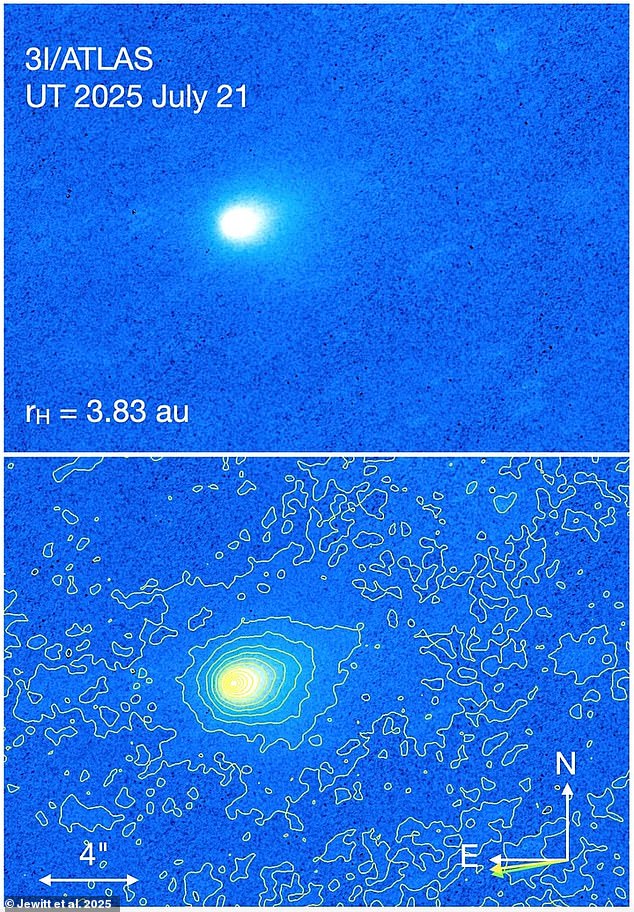The scientific community is embroiled in a heated debate over the origin of a mysterious interstellar object that entered our solar system last month.
While NASA initially identified the object, named 3I/ATLAS, as a comet after spotting what appeared to be a tail, Harvard astrophysicist Avi Loeb publicly challenged that conclusion on Thursday.
Speaking to CNN, Loeb revealed that the object’s unusual brightness suggests it is ‘not a common thing.’
‘The brightness of the object implies a diameter of 12 miles, and there is not enough rocky material in interstellar space to deliver such a giant object per decade,’ he said.
NASA’s Hubble Space Telescope captured images of the object on July 21, revealing a glowing area at its front, something never before observed in a comet.
‘Usually, for comets, you see a tail trailing behind the object,’ said Loeb. ‘Here, the glow is actually in front of it. We’ve never seen such a thing. A comet doesn’t glow in front.’
Loeb has also raised the possibility that the object may not be natural at all.
‘It may come to save us or destroy us,’ the professor said. ‘We’d better be ready for both options and check whether all interstellar objects are rocks.’

The Hubble Space Telescope image of 3I/ATLAS shows a faint glow spreading out in front of the object as it moves toward the sun

The interstellar object is believed to be a comet, but Harvard astrophysicist Avi Loeb contends it could be an alien craft
Chris Lintott, an astronomer at the University of Oxford, told Live Science that Loeb’s theory is ‘nonsense on stilts,’ calling it ‘an insult to the exciting work going on to understand this object.’
However, Loeb said his analysis remains rooted in observational data.
He told CNN that another clue that the object is not natural is its ‘very finely tuned’ trajectory.
‘It lies in the plane of the orbits of the planets around the sun to within five degrees,’ Loeb explained.
According to him, the odds of that alignment happening by chance are one in 500. Even more striking, he says, is how closely the object passes Jupiter, Mars, and Venus, a pattern with odds of 1 in 20,000 if the arrival time were randomized.
‘It will arrive closest to the sun when the Earth is on the opposite side. We won’t be able to observe it. But that’s the perfect time for it to maneuver.’
By ‘maneuver,’ Loeb refers to his theory that the object might use its solar flyby in October as a stealthy approach window, if it is, in fact, an alien probe.
Among his more provocative theories, Loeb wrote on his blog that 3I/ATLAS could be an alien mothership releasing small probes to intercept Earth.
Telescopes have been tracking the course of 3I/ATLAS as it travels through our solar system in 2025 and 2026

Images of 3I/ATLAS taken on July 4 and July 29, 2025, show no sign of a comet tail. The arrows in the images indicate the directions of the sun, north, east and the way the object is moving through space
‘The more likely scenario from an engineering perspective involves a mothership that releases mini-probes which perform a reverse Oberth maneuver to slow down at perihelion and intercept Earth,’ Loeb wrote.
This type of maneuver uses the sun’s gravitational pull at the object’s closest approach to adjust the trajectory efficiently, allowing it to reach Earth without large amounts of fuel.
‘So, we just need to watch it. I’m not saying it’s an alien technology, I’m just saying it doesn’t look like a very common thing,’ Loeb told CNN.
‘Why should we assume that we are the only ones in our cosmic neighborhood? We should just check by looking at the data.’
While NASA reported observing a tail, Loeb and his team recently determined that no such thing exists.
‘There were claims of a tail,’ he said, ‘but since 3I/ATLAS is accelerating and its current size is not much larger than the angular resolution of Earth-based telescopes, it is not easy to avoid fictitious elongation of the image as a result of the object’s motion.’
He also questioned the object’s unusual lack of gas emissions and its precise, retrograde trajectory, which aligns suspiciously well with the inner solar system.
Loeb has developed what he calls the ‘Loeb Scale’, a ranking system to evaluate the likelihood that an object is artificial, and gave 3I/ATLAS a six out of ten.
That suggests it is more likely than not to be engineered, though he emphasized that this score may change as more data becomes available.
This article was originally published by a www.dailymail.co.uk . Read the Original article here. .

